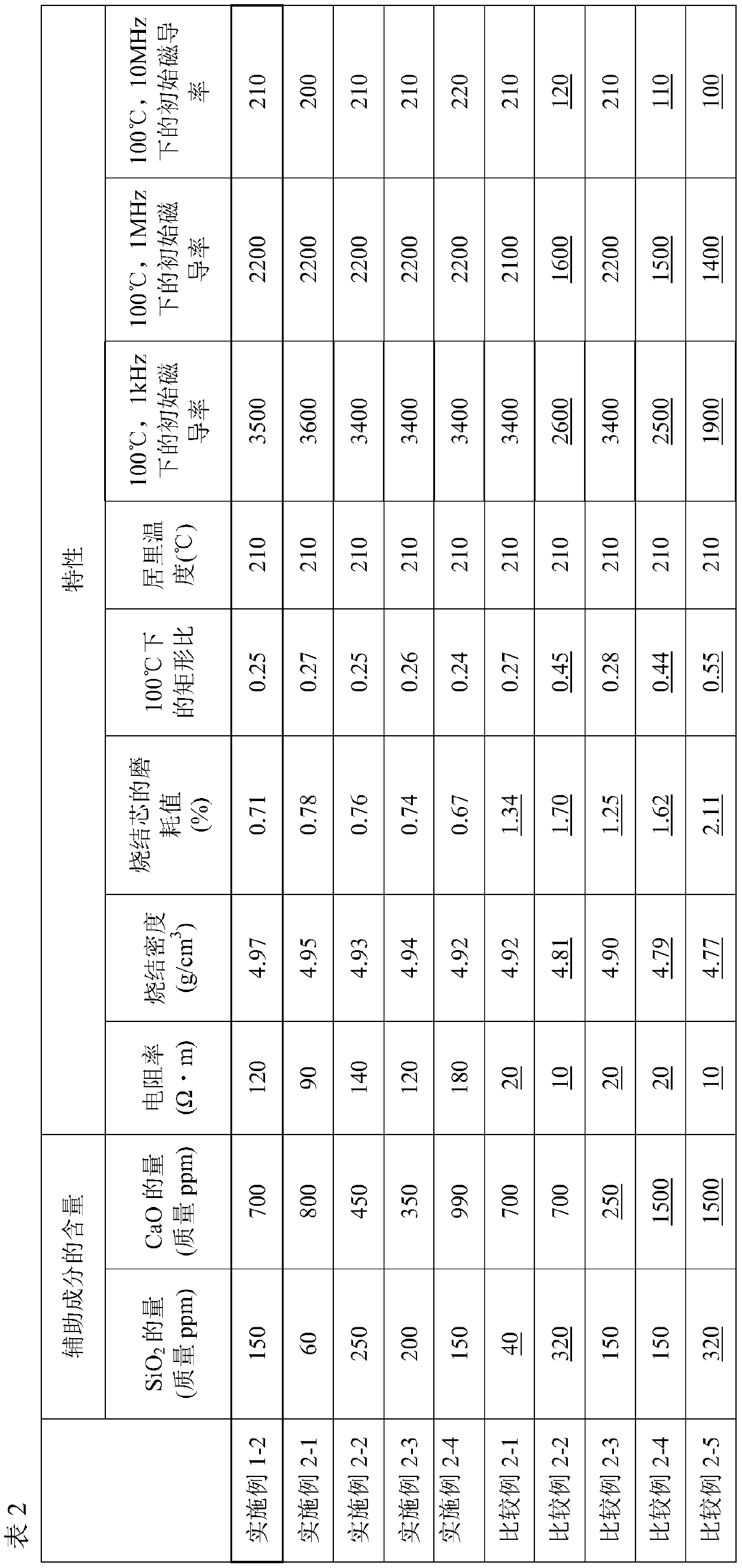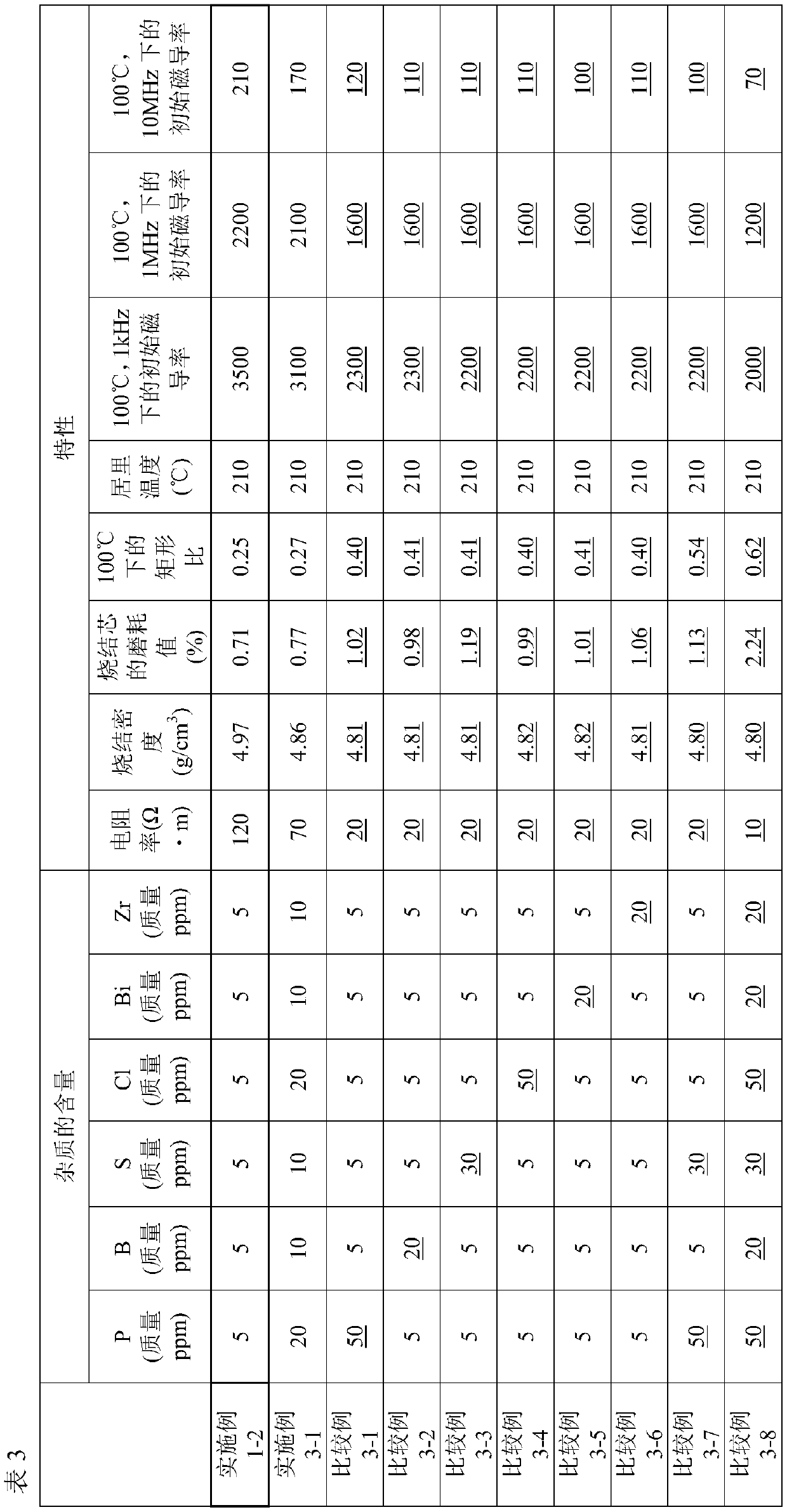MnCoZn ferrite and production method for same
A manufacturing method, ferrite technology, applied in chemical instruments and methods, inorganic chemistry, inorganic material magnetism, etc., can solve the problems of insufficient grain boundary formation, lower resistivity, etc., and achieve the suppression of abnormal particle growth, squareness ratio, etc. Low, excellent damage resistance effect
- Summary
- Abstract
- Description
- Claims
- Application Information
AI Technical Summary
Problems solved by technology
Method used
Image
Examples
Embodiment 1
[0117] After converting all the iron, zinc, cobalt and manganese contained into Fe 2 o 3 , ZnO, CoO and MnO, weigh Fe according to the ratio shown in Table 1 2 o 3 , the amounts of ZnO, CoO and MnO, each raw material powder was mixed for 16 hours using a ball mill, and then calcined at 925° C. in air for 3 hours. Then, weigh SiO equivalent to 150 and 700 mass ppm equivalents, respectively 2 and CaO, it was added to the calcined powder and pulverized using a ball mill for 12 hours. Next, polyvinyl alcohol was added to the obtained pulverized slurry, spray-dried and granulated at an exhaust air temperature of 250 °C, coarse powder was removed through a sieve with a mesh size of 350 μm, and then a pressure of 118 MPa was applied to form a ring core and rectangular core. In addition, due to the use of high-purity raw materials, and before use, media such as ball mills are thoroughly cleaned to reduce the mixing of components derived from other materials, so the impurities P, ...
Embodiment 2
[0133] After converting all the iron, zinc, cobalt and manganese contained into Fe 2 o 3 , ZnO, CoO and MnO, according to Fe 2 o 3 A composition of 49.0 mol% ZnO, 10.0 mol% ZnO, 2.0 mol% CoO and the balance MnO weighed raw materials, mixed them using a ball mill for 16 hours, and then calcined in air at 925°C for 3 hours. Then, the amount of SiO shown in Table 2 was added to the calcined powder 2and CaO, and pulverized using a ball mill for 12 hours. Next, polyvinyl alcohol was added to the obtained pulverized slurry, spray-dried and granulated at an exhaust air temperature of 250°C, the coarse powder was removed through a sieve with a mesh size of 350 μm, and a pressure of 118 MPa was applied to form an annular core and cylindrical core. In addition, the contents of P, B, S, Cl, Bi, and Zr in both the annular core and the cylindrical core were 5 mass ppm, the particle size distribution d90 of the granulated powder used for molding was 230 μm, and the crushing strength wa...
Embodiment 3
[0143] According to the method shown in Examples 1 and 2, the outer diameter is produced by using the basic ingredients and auxiliary ingredients in the same proportion as in Example 1-2, but using raw materials with different amounts of impurities, or adding ingredients intentionally: 25mm, inner diameter: 15mm, height: sintered body annular core of 5mm, and 5 diameters: 10mm, height: the cylindrical core of 10mm, use the same method and apparatus evaluation characteristic with embodiment 1, and the result that obtains is shown in Table 3. In addition, the particle size distribution d90 of the granulated powder used for molding was 230 μm, and the crushing strength was 1.29 MPa.
[0144] [table 3]
[0145]
[0146] As shown in the table, in Example 3-1 in which the contents of P, B, S, Cl, Bi, and Zr were below the prescribed values, the strength expressed as the abrasion value, and the squareness ratio at 100°C could be obtained , resistivity, and magnetic properties in...
PUM
| Property | Measurement | Unit |
|---|---|---|
| Outer diameter | aaaaa | aaaaa |
| The inside diameter of | aaaaa | aaaaa |
| Resistivity | aaaaa | aaaaa |
Abstract
Description
Claims
Application Information
 Login to View More
Login to View More - R&D
- Intellectual Property
- Life Sciences
- Materials
- Tech Scout
- Unparalleled Data Quality
- Higher Quality Content
- 60% Fewer Hallucinations
Browse by: Latest US Patents, China's latest patents, Technical Efficacy Thesaurus, Application Domain, Technology Topic, Popular Technical Reports.
© 2025 PatSnap. All rights reserved.Legal|Privacy policy|Modern Slavery Act Transparency Statement|Sitemap|About US| Contact US: help@patsnap.com



